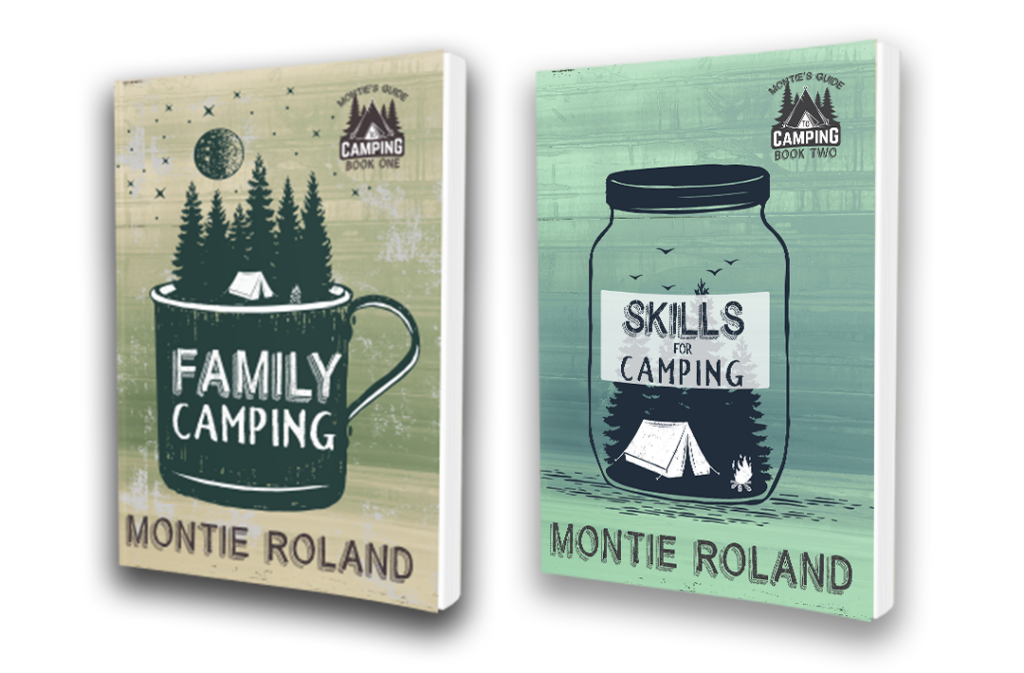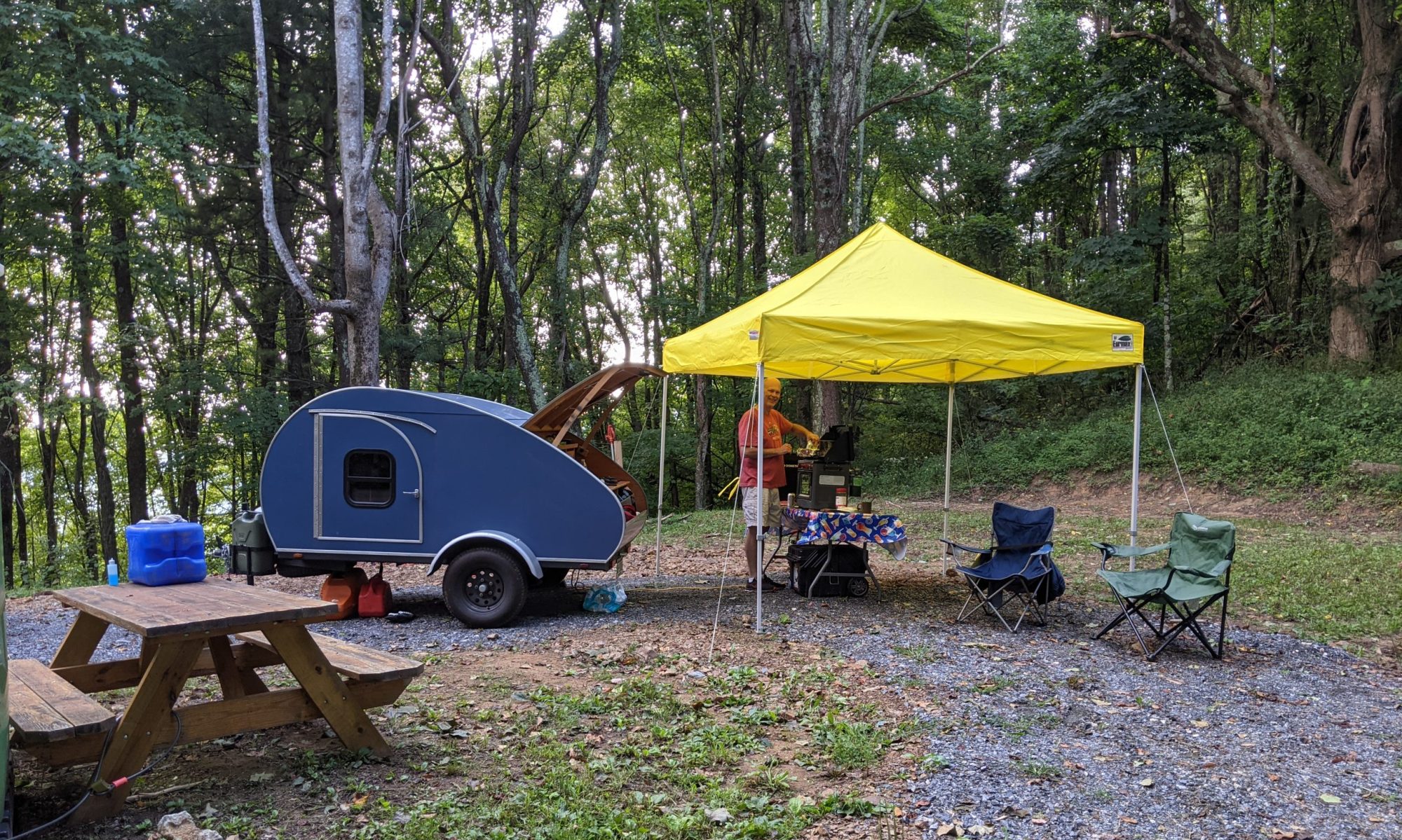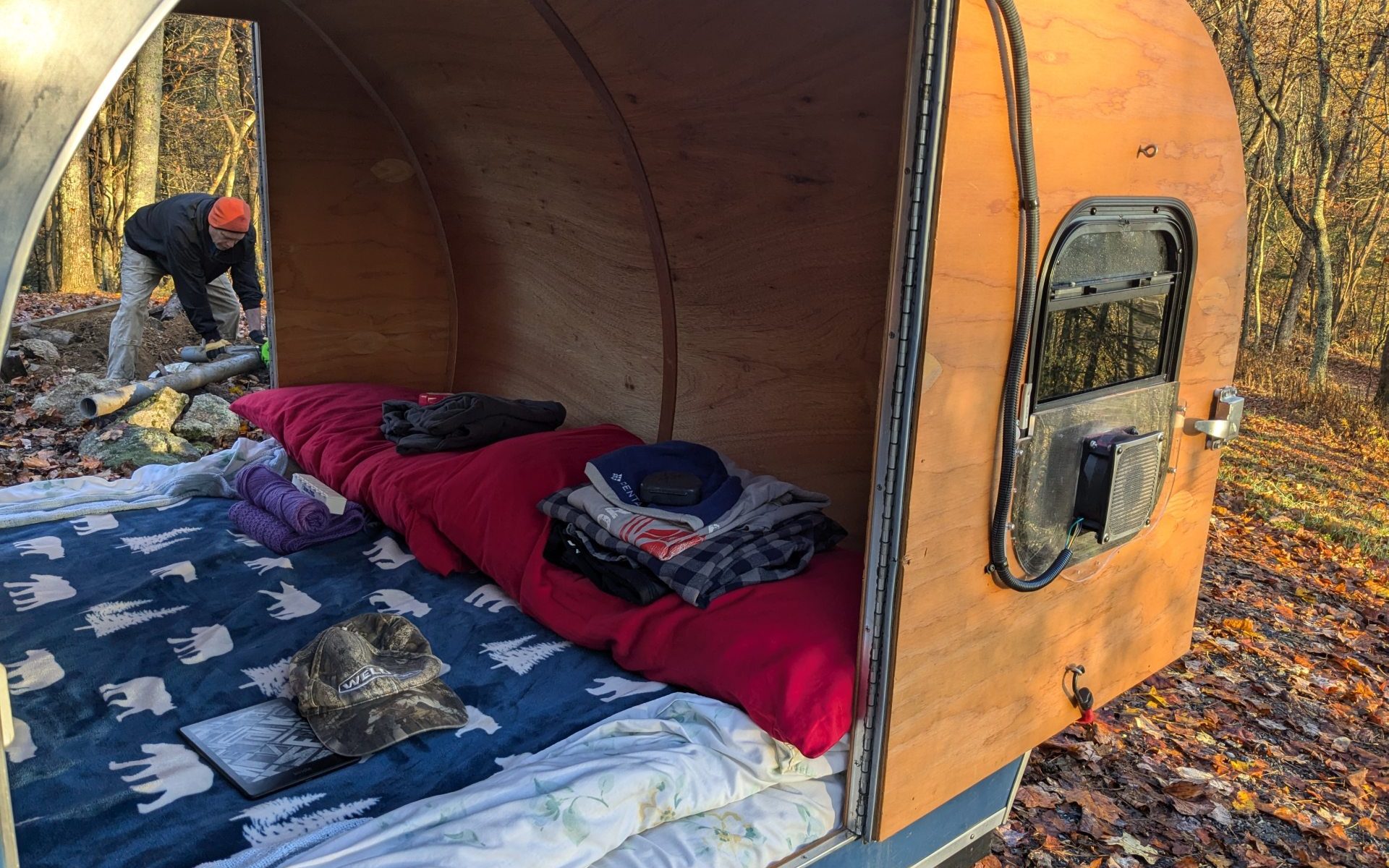Even the best sleeping bag will have fairly limited usefulness without support. Given that, let’s talk about the broader topic which is your sleeping system.
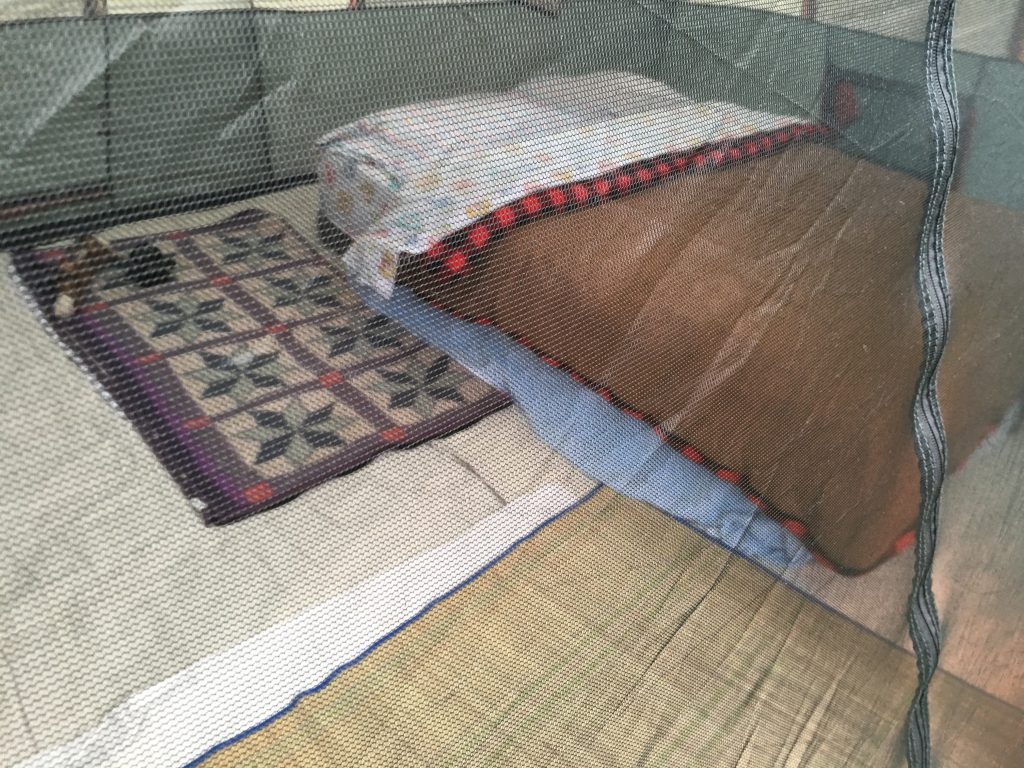
Your sleeping system.
A sleeping system is made up of four elements. The first is the tent, which prevents rain and snow off of you. But, it also keeps wind away. When you’re outside and the wind is blowing, you feel colder. So, a tent keeps cold air at bay and traps static air in the tent. The ventilation a tent provides is also important in hot, humid weather. We’ll talk about types of tents in a later chapter. Hammock tents, commonly referred to as Enos, are another popular option. However they are nice for solo trips and require trees the right distance apart. Hammock tents are best for more advanced campers, not a family trip.
Your sleeping bag.
The second element in the sleeping system is either a sleeping bag or sheets and blankets. A sleeping bag keeps you warm by creating tens of thousands of small pockets of air. There are a variety technologies for doing that—down, Hollofil, Quallofil, or a simple polyester fill. Keep in mind these options come in different price points.
Sleeping Bag Temperature Ratings
The temperature rating on a sleeping bag is the lowest outside temperature where you are still comfortable. The rating assumes you have an insulated pad under the sleeping bag and are sleeping in long underwear. This also won’t account for the cooling effects of wind chill , but your tent protects you from the wind. It is very important to keep in mind that some people sleep warmer than others and the temperature ratings of sleeping bags vary from manufacturer to manufacturer.
A ten degree bag will be very warm in the summer, while a fifty degree bag will be very cold on a thirty-five degree night. One way to extend the temperature range of your bag is to use a sleeping bag liner. A liner is good for approximately ten additional degrees of warmth. You can also use the liner by itself when it is really warm out.
However, for your first trip you may want to consider sheets and blankets on an air bed instead of buying sleeping bags. Another option is to borrow sleeping bags from friends or family. You may also be able to find used camping equipment. You can wash a used sleeping bag before you take it camping.
The down option.
You pay for quality and technology in a sleeping bag. The technology used is often designed to keep you somewhat warm, even if the sleeping bag gets wet. For example, a down bag is compact, lightweight, and tends to be warm. That makes it the perfect option for backpacking; but when wet, a down bag is pretty close to useless. The key is to keep it dry while it is in your pack and when it is spread out in the tent. The need to keep a down bag dry and the additional cost are reasons to avoid a down bag for your first trip. If you’re embarking on your first trip and you plan to car camp, it may be wise to start with blankets and comforters that you have at home. That way you’ve lowered your initial investment. Once you enjoy your first camping trip, you can consider purchasing additional pieces for future endeavors.
The Quallofil, Hollofil filled bags.
Bags that are designed to keep you warm even if they get wet are Quallofil or Hollofil filled. They are made up of a variety of fibers that have different ways of maintaining a space of trapped air. Sometimes those fibers are hollow and there may be other strategies; but the idea here is even if that sleeping bag gets somewhat wet, you’re going to keep some of the warmth, which could be a lifesaver in a difficult situation. Also, either of these bags will dry quicker than down.
The polyester option.
When we think about family camping, the least expensive option, polyester filled bag, comes to mind. These bags are inexpensive but have a limited temperature range. You’ll want to make sure your bag is rated to a temperature at least 10 degrees below the lowest temperature you expect to see at that location. Polyester filled bags don’t stay warm if they get wet but their low cost can make them an attractive option for your first car camping trip. Instead of an inexpensive sleeping bag, consider saving more money and bring sheets and blankets from home.
Two-person sleeping bag.
Another option is a two-person sleeping bag. You can purchase them at Bass Pro shops or other sporting goods stores. Often the two-person bags are very warm and comfortable. There are rectangular one-person bags that can be zipped together to form a two-person sleeping bag. We’ve got a couple of those. And those are awesome. You know, they’re covered with duck cloth on one side and flannel cotton lining on the inside. They’ve got a lot of fill material. And they’re really warm. I think we spent eighty bucks each at Bass Pro Shops. Though, I would never take that backpacking because it’s monstrous and heavy. But, for car camping where I really don’t have a weight and space constraint, it’s really comfortable because you get in that sleeping bag and it’s soft and warm. That sleeping bag is keeping you warm by trapping small pockets of air around your body. Those pockets of air act as insulators.
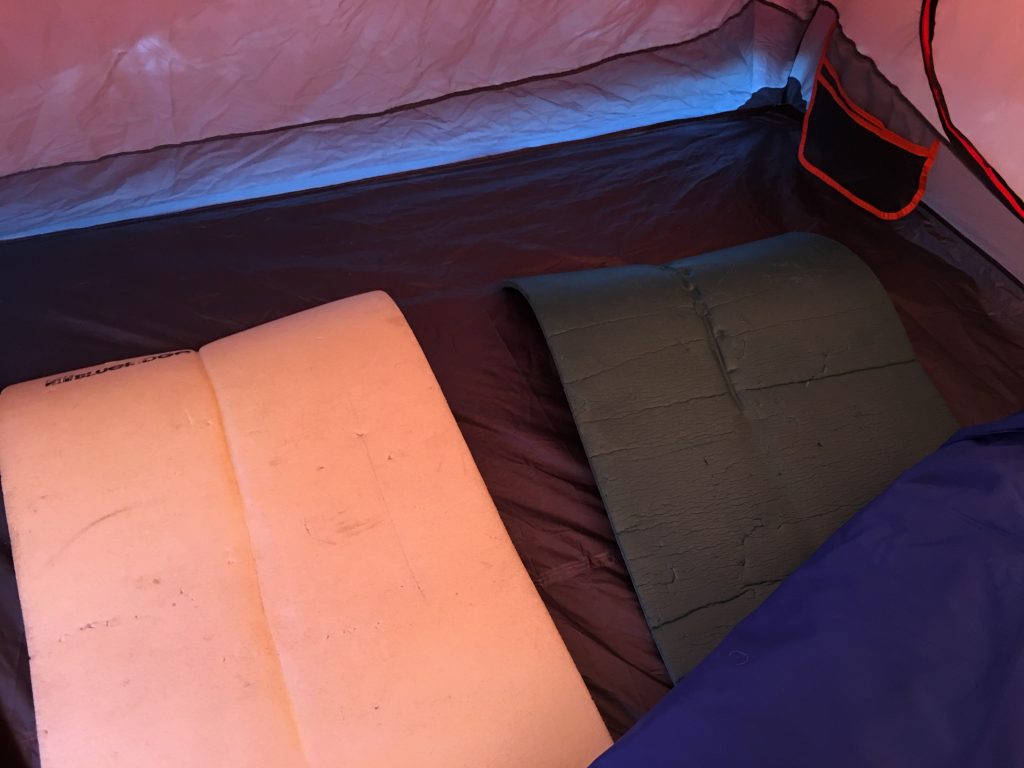
Add a pad under the sleeping bag.
The third part of your sleeping system is an insulated pad. The pad underneath your sleeping bag is a necessity. Keep in mind you don’t have to go out and buy everyone a three hundred dollar bag just to go camping for the weekend. Don’t think of the sleeping bag as a completed product, think about the system you’re using to sleep with. For example, a simple system for backpacking would be a sleeping bag, a tent, and a pad underneath you. The pad is used for thermal insulation, comfort, and keeps you from getting cold. Your body weight compresses your sleeping bag, which loses the effectiveness of the insulation. So, if you don’t have a pad underneath the sleeping bag, you’re going to be very cold. The concept is that air will be trapped above you but not below, therefore precious heat is lost into the ground.
Pads available.
There are several different pads available at various price points. You can choose either foam, self-inflating, or an inflatable pad. A self-inflating pad actually inflates on its own when you roll it out whereas you have to blow up an inflatable pad. I’ve used the inflatable and foam, and they both work great. The difference with both types of inflatable is that when not in use they flatten down and are small and lightweight.
The inflatable pads and beds are really awesome as long as there’s no leak. The risk with a leak is then you are sleeping on the ground. You may be able to temporarily patch an inflatable pad, if you can find the puncture. If the leak is occurring in the area where the pump attaches, then it may not be possible to repair the inflatable pad or bed. It’s difficult to patch an inflatable pad in the best of circumstances. If the patch mostly holds then you may get part of a night of sleep before the pad or bed deflates and you are sleeping directly on the ground. Foam pads, as opposed to inflatable, don’t fail, are fairly inexpensive, and last a long time. Though they take the most space of all three, they can get wet and still get the job done. Don’t forget that with car camping you can use heavier and more bulky items that tend to cost less and last longer because you only need to lug them from the car to your campsite. On the flip side, if you are hiking several miles into the woods, you would want to go with one of the inflating pads as they are significantly lighter and much less bulky.
If the weather is warm, perhaps fifty degrees or higher, you probably won’t need a pad under your air mattress. However, the foam pad is a great backup in case your air mattress leaks or for some reason you aren’t able to pump it up.
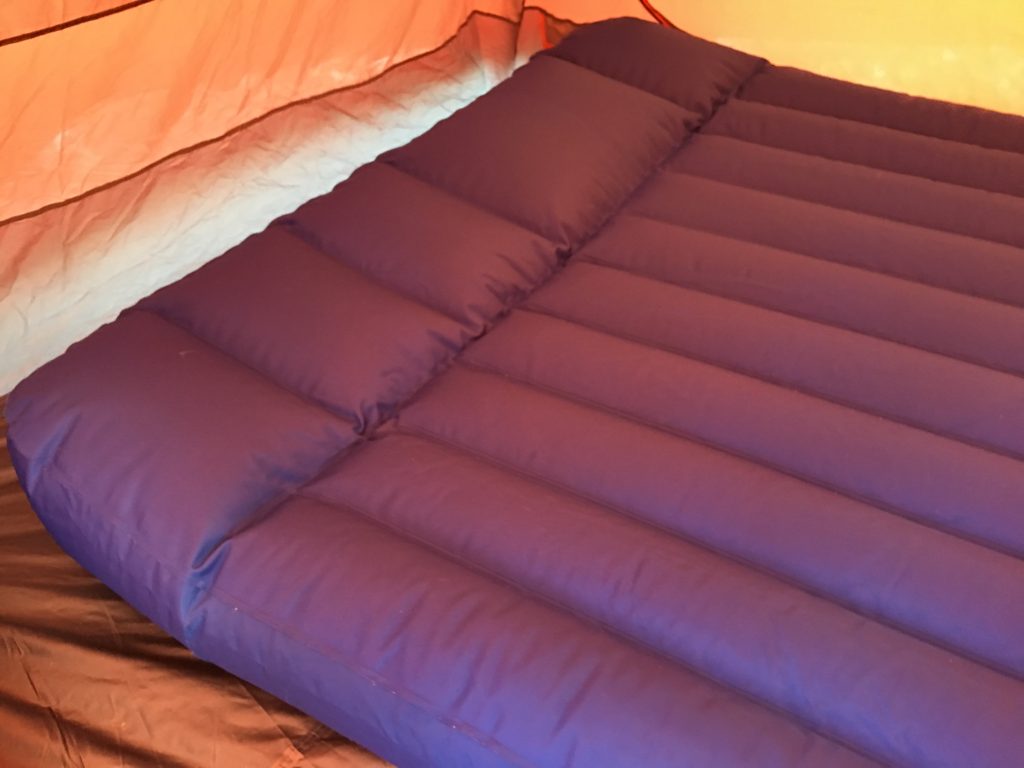
Possibly add an air-mattress under your sleeping bag.
The fourth and final part of your sleep system is to add an air mattress between the pad and the sleeping bag. You will still need a pad if it is cold to retain heat. If you are backpacking, you wouldn’t take an air mattress. If you are car camping, the air mattress makes your sleeping experience in the tent much more comfortable.
Another neat thing about an air mattress is that it can do double duty. If you invest in one for camping, you can still use it in your home for company. When camping without electricity, you’ll need to invest in a D-cell battery pump, or a pump that runs off the cigarette lighter in your car, to inflate up the mattress. You can also use a hand pump, which is less expensive, it just takes longer to inflate. I will say check your air mattress before you leave home because if it has a leak, you have a problem. And usually you’ll have to pump them up every day and a half or so while camping. Keep in mind that the older you get, the more you might appreciate the feel of an air-mattress. It will keep you a foot off the ground and allow you to get up and down easier. So we age, an air-mattress may be a way to extend your ability to camp longer throughout your life.
The air mattress, or inflatable bed, is inexpensive and come in sizes as large as queen. Since you are car camping for your first trip, the size of the bed when it’s packed up isn’t usually a big issue. Make sure that your an inflatable bed actually fits in your tent before you get to the campsite. I know I keep mentioning this, but setting up your tent and air mattress at home, before you leave to go camping, is always a great idea.
One caution I have for you is to carefully explain to everyone to not plop down on an air-mattress. If that air mattress fails it’s going to be a long night sleeping on the ground which is pretty hard.
How an air-mattress can feel like home.
We have a queen-size air-mattress, a single rectangular sleeping bag, and two single bags that are very large. Given those tools, my wife will lay a bedspread or a blanket on top of the blown-up air-mattress and then a fitted sheet over that. Then, Connie will put a regular sheet over that and lay the single rectangular sleeping bag on top. Finally, she’ll zip the two single bags onto the square one on the bottom—creating a roomy homemade double sleeping bag. This setup is very comfy and warm and feels more like the bed at home than a slick sleeping bag on a backpacking pad. This homey feeling makes the sleeping part of camping more comfortable and more like the bed at home. This is a win for everyone because a good night’s sleep helps make for a good next day.
For your first camping trip, you can make it simple and place a double sleeping bag on top of the air-mattress and call it a day. Of course, you can also do this with a blanket or a comforter, and then there is no need for a sleeping bag. Be cautious with using comforters from the home because many times they are dry-clean only or too large to fit in your in-home washing machine when they get muddy or dirty. On the other hand, sleeping bags and blankets can go through the wash with no worry. Note that down bags require a special soap and drying method to keep their loft. It’s not hard, you just need to follow the instructions. You also want to minimize the number of times you wash your sleeping bag.
Still use a pad if you have an air mattress.
The air mattress has you up off the ground and provides some insulation, but it’s this giant pocket of air, so it’s not as effective as a pad, which contains lot of small pockets. That big air mattress has limited insulation and can allow you to feel the cold ground below. So, when the weather is cold, make sure to include an insulated pad between the mattress and the ground. This will help keep you warm. Depending on the size of the air mattress you may need to put two insulated pads side by side.
Recap of sleeping system.
So that gives you a system, possibly for a low cost. Your linen closet contained the blankets, comforters, and sheets, if you choose not to purchase sleeping bags. You may have already owned an air mattress or can borrow one from a friend or neighbor. Now, at minimal cost, you’re prepared to go camping. And you’re extremely comfortable. By doing this, you can get an idea if your family enjoys camping. If they do, then you can begin to invest in more products to keep yourself warm and comfortable.
Planning can make all the difference in attitude.
If you follow my steps and plan for a quality tent that won’t leak, a pad to keep the cold and wet from your bedding, an air-mattress for comfort, and warm coverings to snuggle under—whether it be a sleeping bag or blankets and comforters—everyone at the campsite will be warm and comfortable. The system will feel much like their bed at home. Everyone will get a good night’s sleep because you’ve created this amazingly satisfying environment to sleep in that is similar to their bed at home.
The first night.
For me, a lot of times I don’t sleep well the first night because I’m out of my normal element. But there’s a big difference in levels of not sleeping well. For example, if I’m laying on the ground on a pad in a mummy bag, I’m probably going to, that first night, sleep less than if I’m snuggled up to my wife on an air mattress, all warm and everything’s wonderful. It’s a lot easier on that big, thick air mattress to get a better night’s sleep that first night.
Subsequent nights.
Usually, the second night I sleep pretty good, it’s the first night that gets me. I think that means I’m mentally and emotionally in a better position the next day to be friendly and loving and kind, and not grumpy because I didn’t get enough sleep. Given this, don’t feel like that there’s anything wrong with bringing the comforts of home with you.
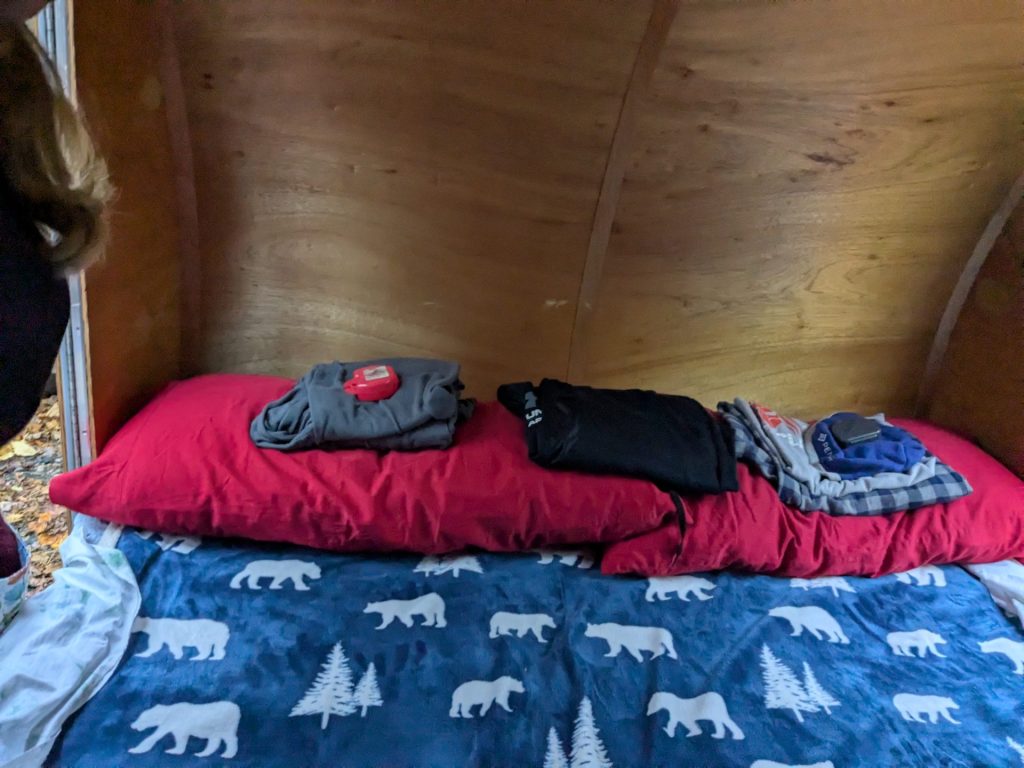
Encouragement.
The big thing is that I want to encourage y’all to get out and enjoy the outdoors. By all means, if you’ve got to do a little more “glamping”, or glamorous camping, than just playing camping that’s just fine. It’s all a process. Each trip puts you one step closer to having the skills you need for the next level. It also puts you one step closer to say a backpacking trip, or some more adventurous type camping. Or maybe you stay in the glamping stage forever, that’s fine as well.
After the Camping Trip
I only wash a sleeping bag when I have to. If it’s muddy or dirty or smells, it needs to be washed. I ALWAYS air out sleeping bags well after a trip. I have a rail above the stairs that allows me to leave the sleeping bag open while hanging over the rail. You can also just leave them open on the floor or on your bed. Make sure your sleeping bags are dry and clean before storing. If you let it mildew, it is very difficult to get that odor out. Don’t roll up your sleeping bag tightly for storage, or put it in a compression sack, instead store in a dust free environment or loosely in a bag. That will help prevent the sleeping bag from losing its loft, and the warmth the loft helps create.
Can I say…
You are on your way to developing a love of the outdoors, along with the skills and sense of freedom necessary for camping. If you want to push yourself with each trip, go for it! Otherwise, enjoy the outdoors in whatever set-up works for you and your family.
These tips on the sleeping system are great ways to keep everyone comfortable and give them a good night’s sleep. I think that helps the overall camping experience. So, get on out there and enjoy the outdoors while camping.
Check out my books on camping
